- List of Indoor Palms (Continued)
- 7. Bamboo Palm (Chamaedorea seifrizii)
- 8. Lady Palm (Rhapis excelsa)
- 9. Kentia Palm (Howea forsteriana)
- 10. Parlor Palm (Chamaedorea elegans)
- 11. Areca Palm (Dypsis lutescens)
- 12. Pygmy Date Palm (Phoenix roebelenii)
- Best Palm Trees for Indoor Décor
- Majesty Palm
- Description
- Light
- Watering
- Temperature
- Humidity
- Fertilizing
- Pruning
- Potting and Repotting
- Pests and Diseases
- Conclusion
- Areca Palm
- Appearance
- Care
- Benefits
- Conclusion
- Parlor Palm
- Appearance
- Care Requirements
- Benefits
- Common Problems
- Conclusion
- Kentia Palm
- Bamboo Palm
- Lady Palm
- Pygmy Date Palm
- Description
- Care Guide
- Benefits
- Conclusion
- Fishtail Palm
- Appearance
- Care
- Benefits
- Q&A:
- What are some of the best indoor palm trees for small spaces?
- Can indoor palm trees survive in low light conditions?
- Do indoor palm trees require a lot of maintenance?
- What are the benefits of having indoor palm trees?
- Can indoor palm trees be placed in any room of the house?
- Are indoor palm trees safe for pets?
- How long do indoor palm trees usually live?
- Video: Best Varieties of Palm | 11 Easy Growing Palms at your home you must know| #Nanhapodha #Palmtree
Indoor palm trees are a great way to bring a touch of the tropics into your home or office. They add a sense of relaxation and natural beauty, while also providing health benefits such as improving air quality and reducing stress. In our previous article, we covered some popular indoor palms, and in this continuation, we will explore more varieties that are perfect for indoor décor.
One of the best options for indoor palm trees is the Areca palm (Dypsis lutescens). Known for its feathery, arching fronds, the Areca palm adds a touch of elegance to any space. It is also an excellent air purifier, removing harmful toxins from the air. This palm requires bright, indirect light and regular watering to thrive indoors.
Another popular choice is the Kentia palm (Howea forsteriana), which is often used in luxury hotels and resorts. Its slender, graceful fronds and tall, slender trunk make it a perfect accent in any room. The Kentia palm is low-maintenance and can tolerate lower light conditions, making it a great choice for spaces with less natural light. It also helps to purify the air by removing toxins.
If you are looking for a palm tree with a unique appearance, the Ponytail palm (Beaucarnea recurvata) is worth considering. Its long, curly leaves are reminiscent of a ponytail, hence the name. The Ponytail palm is a slow-growing plant that thrives in bright, indirect light and well-draining soil. It is drought-tolerant and can survive for extended periods without water, making it a great option for forgetful plant owners.
List of Indoor Palms (Continued)
7. Bamboo Palm (Chamaedorea seifrizii)

The Bamboo Palm is a popular choice for indoor décor because of its elegant appearance and air-purifying qualities. This palm can tolerate low light conditions and has a high resistance to pests, making it ideal for indoor spaces.
8. Lady Palm (Rhapis excelsa)
The Lady Palm is known for its delicate fronds and compact size, making it a perfect choice for smaller indoor spaces. It can tolerate low light conditions and moderate watering, making it relatively easy to care for.
9. Kentia Palm (Howea forsteriana)

The Kentia Palm is a classic palm tree that is commonly used in indoor décor. It has elegant arching fronds and can tolerate low light conditions. It is also relatively low maintenance, making it a popular choice for offices and homes.
10. Parlor Palm (Chamaedorea elegans)
The Parlor Palm is a versatile palm tree that can be grown both indoors and outdoors. It has delicate fronds and can tolerate low light conditions. It is also known for its air-purifying qualities, making it a great choice for improving indoor air quality.
11. Areca Palm (Dypsis lutescens)
The Areca Palm is a popular choice for indoor décor because of its graceful appearance and air-purifying qualities. It has feathery fronds and can tolerate low light conditions. It is relatively easy to care for and can add a touch of tropical elegance to any indoor space.
12. Pygmy Date Palm (Phoenix roebelenii)
The Pygmy Date Palm is a small palm tree that is perfect for indoor spaces. It has slender fronds and can tolerate low light conditions. It is relatively low maintenance and can add a touch of natural beauty to any indoor setting.
- Bamboo Palm
- Lady Palm
- Kentia Palm
- Parlor Palm
- Areca Palm
- Pygmy Date Palm
These are just a few examples of the many different types of indoor palms that can be used for indoor décor. Each palm tree has its own unique characteristics and care requirements, so it is important to choose one that suits your specific needs and the conditions of your indoor space.
Best Palm Trees for Indoor Décor
When it comes to choosing the perfect palm tree for your indoor décor, there are several factors to consider. You’ll want to choose a palm that can thrive indoors, has an attractive appearance, and is easy to care for. Here are some of the best palm trees for indoor décor:
Kentia Palm (Howea forsteriana): This elegant palm is native to Lord Howe Island and is known for its slender trunk and arching fronds. It can tolerate low light conditions, making it a popular choice for indoor settings.
Areca Palm (Dypsis lutescens): Also known as the butterfly palm, this palm tree features feathery, arching fronds that can add a touch of tropical beauty to any space. It prefers bright, indirect light and moderate humidity.
Ponytail Palm (Beaucarnea recurvata): Despite its name, this palm tree is not actually a true palm. It is known for its bulbous trunk and long, curving leaves that resemble a ponytail. It thrives in bright, indirect light and can tolerate periods of drought.
Parlor Palm (Chamaedorea elegans): This compact palm is native to Mexico and Guatemala and is a popular choice for indoor décor. It has delicate, arching fronds and can tolerate low light and dry indoor conditions.
These palm trees are just a few examples of the many options available for indoor décor. When choosing a palm tree for your space, be sure to consider its care requirements and the amount of light and humidity available in your home. With the right palm tree, you can bring a touch of the tropics into your indoor space.
| Palm Tree | Light Requirements | Watering Needs | Height |
|---|---|---|---|
| Kentia Palm | Low to medium light | Moderate | 8-10 feet |
| Areca Palm | Bright, indirect light | Moderate | 6-7 feet |
| Ponytail Palm | Bright, indirect light | Low | 10-15 feet |
| Parlor Palm | Low to medium light | Low | 2-6 feet |
“`html
Majesty Palm
Description
The Majesty Palm (Ravenea rivularis) is a popular indoor palm tree that adds a touch of tropical elegance to any interior space. It features long, arching fronds that give it a graceful appearance.
Light
Majesty Palms prefer bright, indirect light. They can tolerate lower light conditions, but they may not grow as quickly or develop their full potential. Avoid placing them in direct sunlight, as it can scorch the leaves.
Watering
Keep the soil of Majesty Palms evenly moist, but not soggy. Water the plant when the top inch of the soil feels dry to the touch. It’s important to avoid overwatering, as it can lead to root rot. Use a well-draining potting mix to prevent waterlogged roots.
Temperature
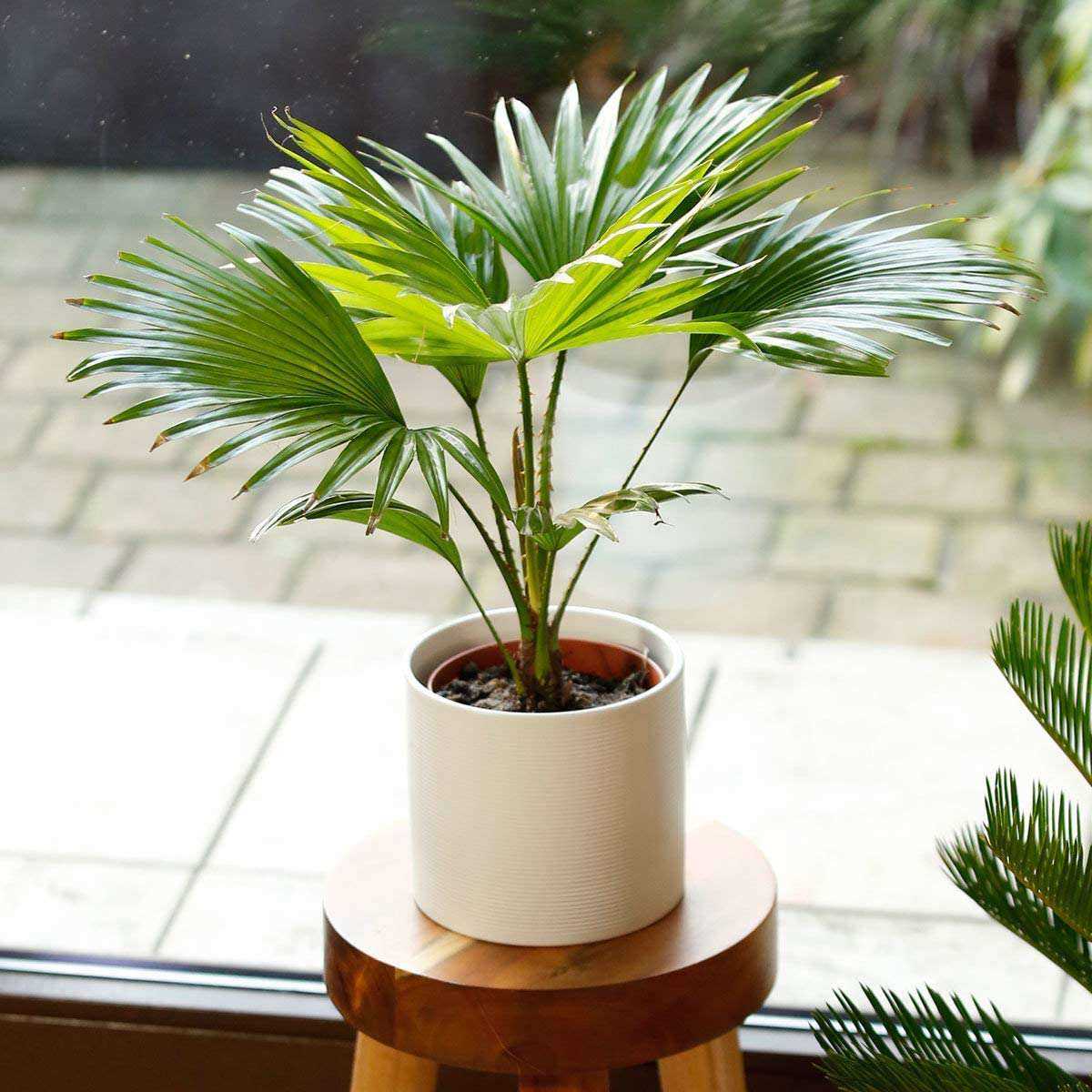
Majesty Palms prefer temperatures between 65-85°F (18-29°C). They are sensitive to cold drafts and sudden temperature changes, so it’s best to keep them away from doors, windows, and air conditioning vents.
Humidity
Majesty Palms thrive in higher humidity environments. Mist the leaves regularly, or place the pot on a tray filled with water and pebbles to increase humidity. You can also use a humidifier to create a more humid environment.
Fertilizing
Feed the Majesty Palm with a balanced, water-soluble fertilizer once a month during the growing season (spring and summer). Follow the package instructions for the correct dosage. Avoid over-fertilizing, as it can cause salt buildup in the soil.
Pruning
Remove any brown or yellow leaves from the Majesty Palm to maintain its appearance. You can also cut back any overly long or unruly fronds to promote a neater growth habit.
Potting and Repotting
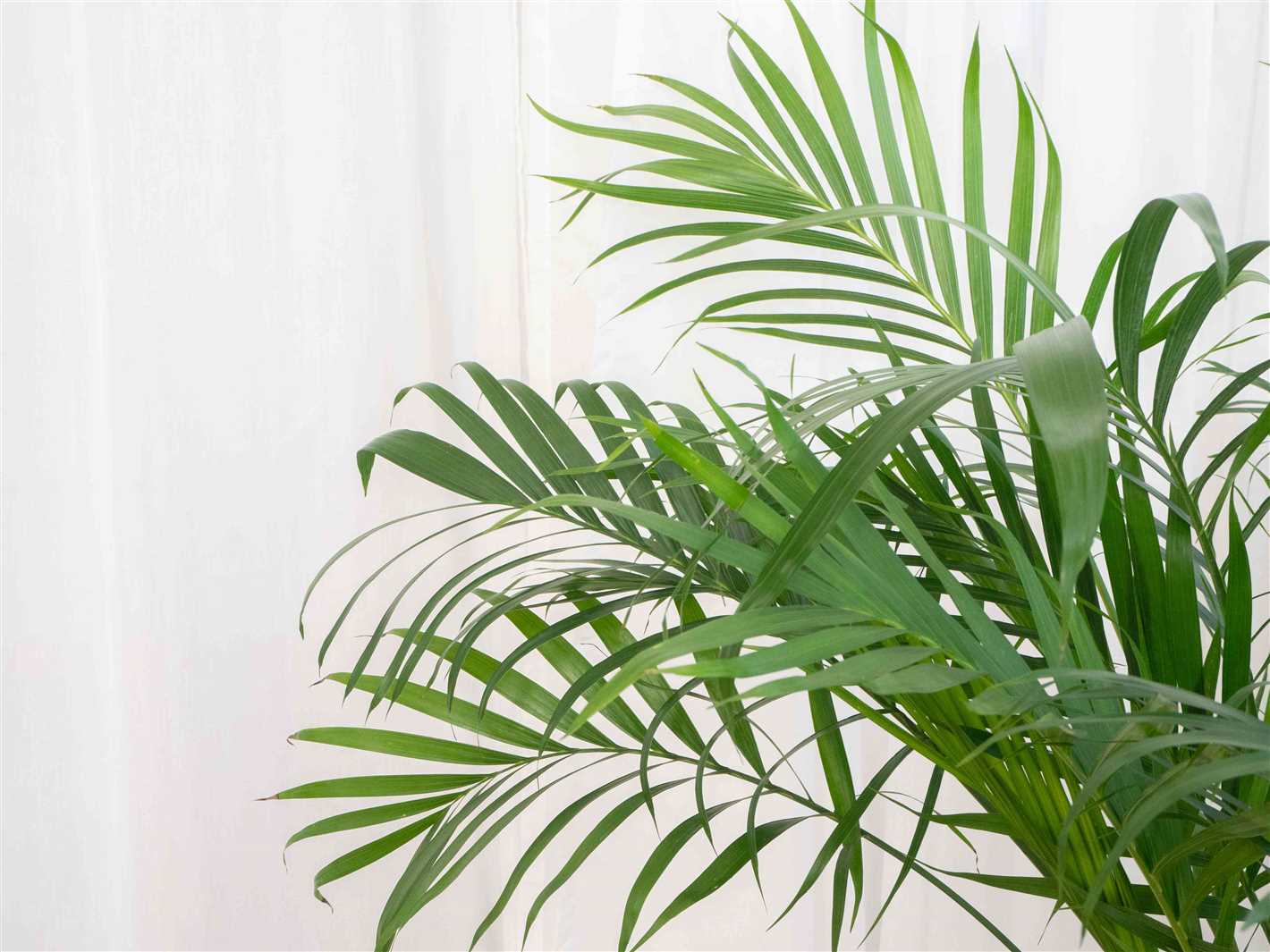
When potting or repotting a Majesty Palm, choose a container that has drainage holes. Use a well-draining potting mix and ensure that the plant is not sitting in water. Repotting should be done every 1-2 years or when the roots start to outgrow the current pot.
Pests and Diseases
Common pests that can affect Majesty Palms include spider mites, mealybugs, and scale insects. Regularly inspect the plant for any signs of pest infestation and treat them immediately. Overwatering can lead to root rot, so it’s important to ensure proper drainage to prevent this issue.
Conclusion
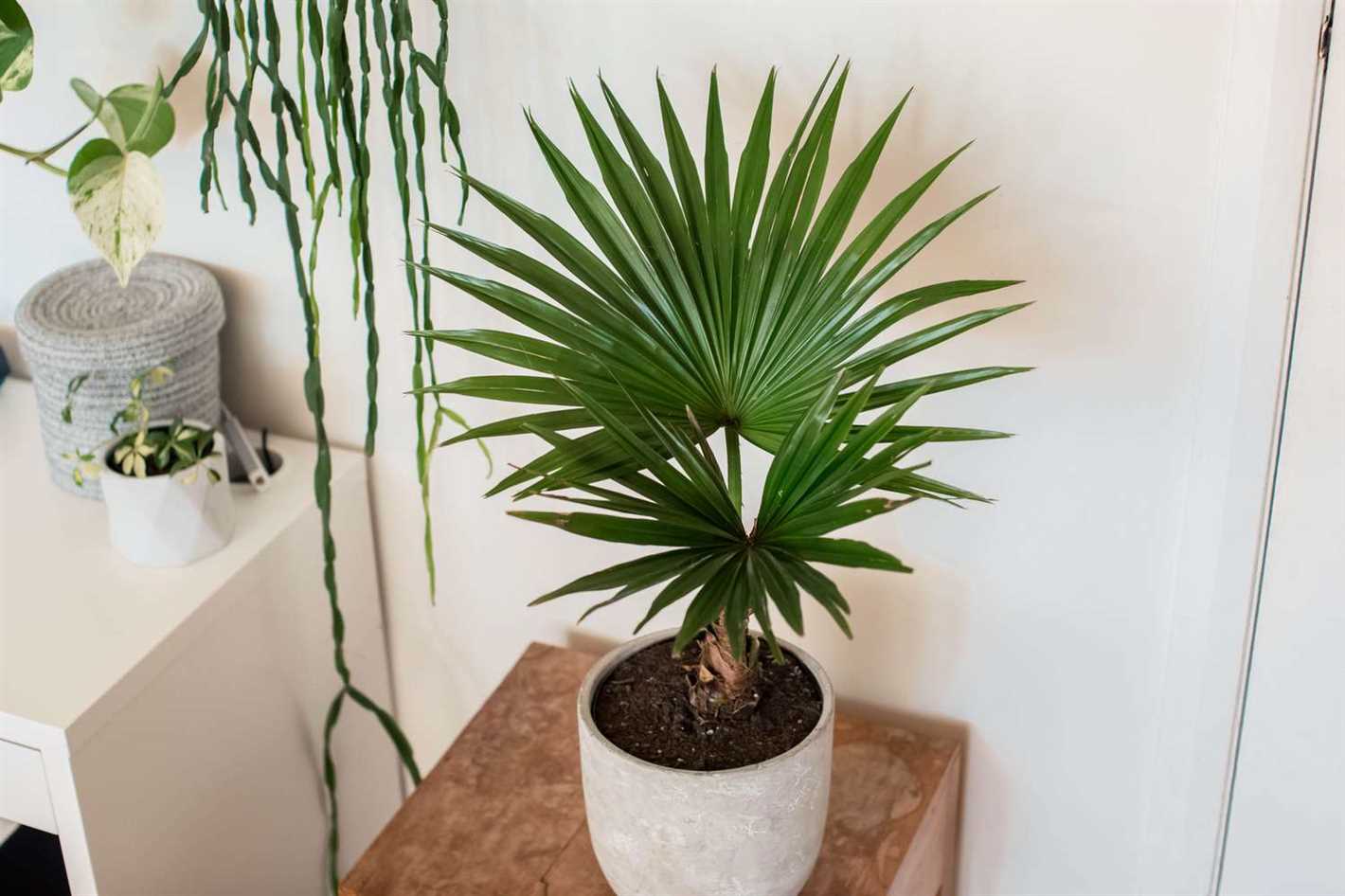
The Majesty Palm is a stunning indoor palm tree that adds a touch of tropical beauty to any indoor space. With proper care, it can thrive and become a focal point in your home or office.
“`
Areca Palm
The Areca Palm, also known as the Dypsis lutescens or Golden Cane Palm, is a popular choice for indoor décor. This palm tree is native to Madagascar and grows well in tropical and subtropical regions.
Appearance
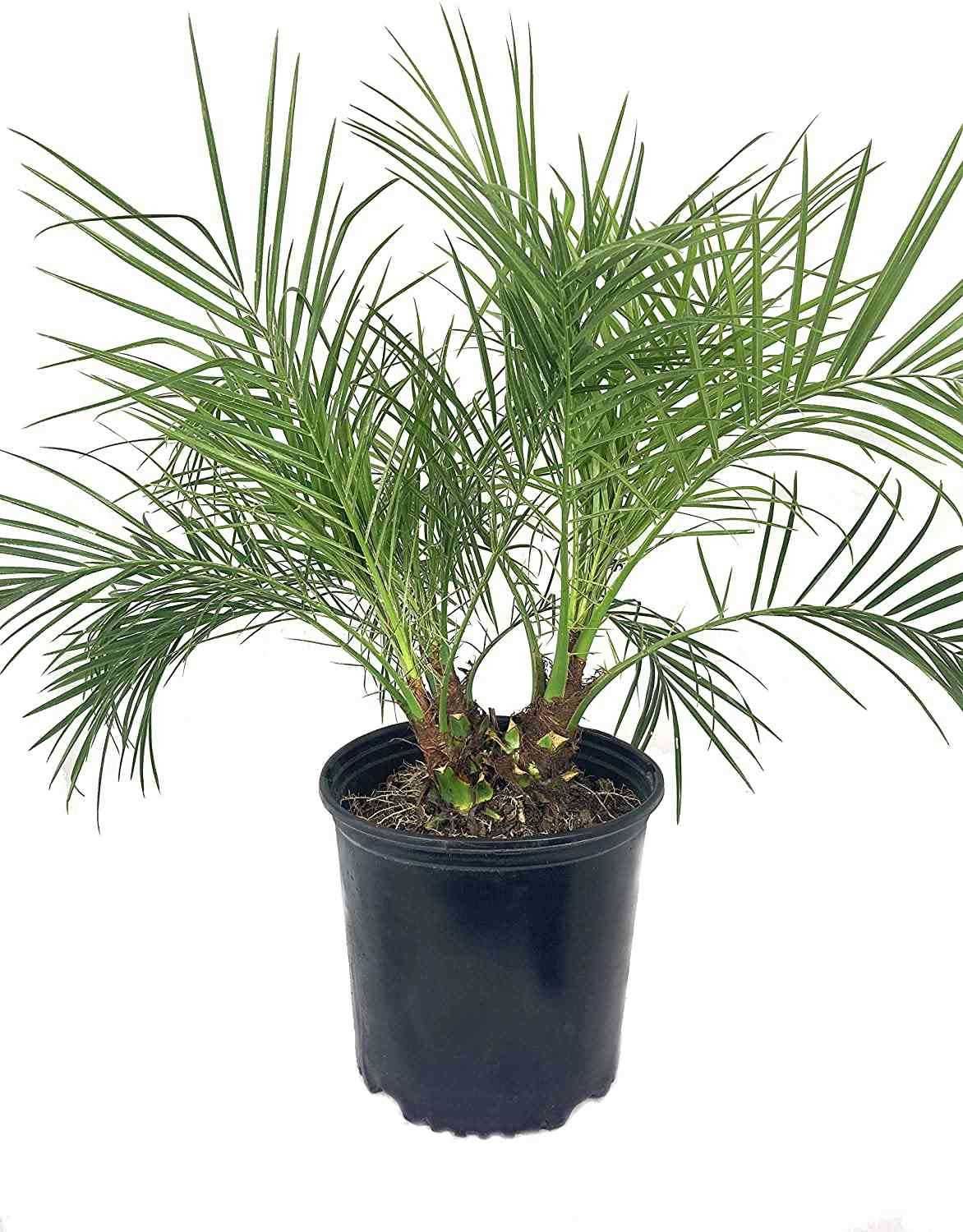
The Areca Palm is characterized by its graceful, feathery fronds that arch from a cluster of stems. The fronds are bright green in color and have a fine texture. The tree can grow up to 6 to 8 feet tall indoors, creating a tropical and exotic ambiance.
Care
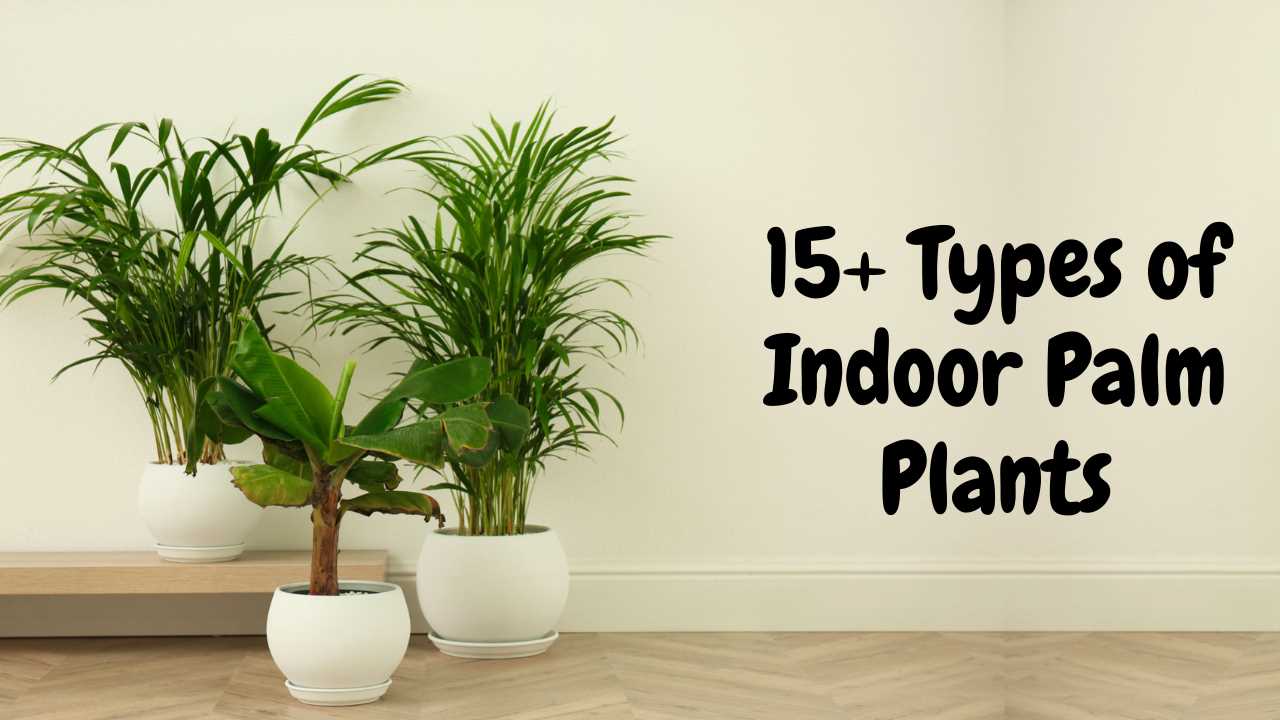
Light: The Areca Palm thrives in bright, indirect light. It can tolerate some shade, but too little light may cause the plant to become weak and leggy. Avoid direct sunlight as it can scorch the fronds.
Water: Keep the soil evenly moist but not soggy. Allow the top inch of soil to dry out between waterings. Overwatering can lead to root rot, so it’s important to ensure proper drainage.
Temperature: This palm tree prefers temperatures between 65°F to 75°F (18°C to 24°C). It can tolerate slightly cooler temperatures but should be protected from drafts and cold air.
Humidity: The Areca Palm thrives in high humidity. Mist the leaves regularly or place the plant on a tray filled with water and pebbles to increase humidity levels.
Fertilizer: Feed the Areca Palm with a balanced, water-soluble fertilizer once a month during the growing season (spring and summer). Avoid over-fertilizing, as it can lead to nutrient burn.
Benefits
The Areca Palm not only adds beauty to indoor spaces but also offers various health benefits. It is known for its air-purifying capabilities and can remove toxins such as formaldehyde, benzene, and trichloroethylene from the air, making it a great choice for improving indoor air quality.
Conclusion
The Areca Palm is a versatile and attractive palm tree that makes a great addition to indoor spaces. With its graceful fronds and air-purifying qualities, it brings a touch of the tropics to any room. Just remember to provide it with the right amount of light, water, and humidity to keep it thriving.
Parlor Palm
The Parlor Palm (Chamaedorea elegans) is a popular choice for indoor decoration due to its elegance and low maintenance requirements. Also known as the Neanthe Bella Palm or the Good Luck Palm, this palm species is native to the rainforests of Southern Mexico and Guatemala.
Appearance
The Parlor Palm is a small palm tree that typically reaches a height of about four to six feet when grown indoors. Its slender, bamboo-like stems are adorned with delicate, feathery, deep green fronds. The fronds are pinnate, meaning they consist of multiple leaflets arranged on either side of the stem.
Care Requirements
The Parlor Palm thrives in bright, indirect light, so it should be placed near a window where it can receive filtered sunlight. It can also tolerate lower light conditions, making it suitable for rooms with limited natural light. The plant should be kept away from direct sunlight, as it can scorch the leaves.
The Parlor Palm prefers temperatures between 65-85°F (18-29°C) and high humidity levels. It should be watered regularly, allowing the top inch of soil to dry out between waterings. Keeping the soil moist but not waterlogged is essential for the health of the plant. It is also important to avoid overwatering, as it may lead to root rot.
Fertilizing the Parlor Palm once every two months during the growing season with a balanced houseplant fertilizer can enhance its growth and foliage color. Trim any brown or yellowing fronds regularly to maintain the plant’s appearance.
Benefits
In addition to its aesthetic appeal, the Parlor Palm offers several benefits. It is an excellent air purifier, capable of removing toxins such as formaldehyde, benzene, and carbon monoxide from the air, making it a great choice for improving indoor air quality. The palm’s lush foliage also helps to add humidity to dry indoor environments, benefiting both the plant and its surroundings.
Common Problems
The Parlor Palm is relatively resistant to pest infestations, but it can occasionally face issues like spider mites or mealybugs. Regularly inspecting the plant for pests and treating them promptly with insecticidal soap or neem oil can help control any infestations.
Yellowing or browning of the leaves can be a sign of improper care or environmental conditions, such as overwatering, underwatering, low humidity, or excessive direct sunlight. Adjusting the care routine and environment accordingly can help restore the plant’s health.
Conclusion
The Parlor Palm is a beautiful and versatile palm tree that can thrive indoors with minimal care. Its lush foliage, air purifying capabilities, and tolerance for low light conditions make it an excellent choice for enhancing the aesthetic appeal and air quality of any indoor space.
Kentia Palm
- Scientific Name: Howea forsteriana
- Origin: Lord Howe Island, Australia
- Common Names: Kentia Palm, Thatch Palm
- Light Requirements: Kentia Palms can tolerate a wide range of lighting conditions, although they prefer bright indirect light.
- Watering: Water the palm thoroughly, allowing the top inch of soil to dry out before watering again. Overwatering can lead to root rot, so make sure the pot has good drainage.
- Temperature: Kentia Palms prefer temperatures between 65 and 75°F (18-24°C). They can tolerate temperatures as low as 50°F (10°C) for short periods.
- Humidity: Kentia Palms prefer higher humidity levels, but they can tolerate average indoor humidity. Misting the leaves or placing a humidifier nearby can help increase humidity.
- Fertilizer: Fertilize the palm every 2-3 months during the spring and summer with a balanced liquid fertilizer. Reduce the frequency to once every 2-3 months during the fall and winter.
- Pruning: Prune any yellow or brown leaves and remove any dead or damaged fronds. Regular pruning is not necessary unless the palm becomes too large for its space.
- Potting and Repotting: Use a well-draining potting mix and a container with drainage holes. Repot the palm every 2-3 years or when it becomes rootbound.
- Pests and Diseases: Kentia Palms are relatively pest and disease-resistant. However, they can occasionally be affected by spider mites, mealybugs, or scale insects. Inspect the plant regularly and treat any infestations promptly.
The Kentia Palm, also known as the Thatch Palm, is a popular choice for indoor decoration due to its elegant appearance and ability to thrive in low-light conditions. It features arching, feather-like fronds and a slender trunk, creating a tropical and graceful look.
This palm is native to Lord Howe Island, located off the east coast of Australia. It can grow up to 10-20 feet (3-6 meters) tall indoors, making it ideal for adding a touch of greenery to living rooms, offices, or other indoor spaces.
To care for a Kentia Palm, provide it with bright indirect light, water it thoroughly but avoid overwatering, and keep it in a temperature range of 65-75°F (18-24°C). This palm prefers higher humidity levels, but it can tolerate average indoor humidity.
Fertilize the palm regularly during the spring and summer months and prune any yellow or brown leaves as needed. Repot the palm every few years or when it becomes rootbound.
Overall, the Kentia Palm is an excellent choice for indoor décor, as it adds a touch of elegance and tropical vibes to any space while being relatively low-maintenance.
Bamboo Palm
The Bamboo Palm, also known as Chamaedorea seifrizii, is a popular indoor palm that is native to Mexico and Central America. It is a relatively small palm, reaching a height of 4 to 12 feet. This palm has slender green stems, which resemble bamboo, hence the name Bamboo Palm.
The Bamboo Palm is an excellent choice for indoor decor due to its ability to thrive in low light conditions. It can tolerate low light and still maintain its lush green appearance. This makes it a perfect choice for office spaces, living rooms, or any other area with limited natural light.
The Bamboo Palm is also known for its ability to purify the air. It is a natural air purifier and is effective in removing airborne toxins such as formaldehyde, benzene, and trichloroethylene. It can help improve indoor air quality and create a healthier living environment.
Caring for a Bamboo Palm is relatively easy. It prefers indirect or filtered light but can tolerate low light conditions. It should be watered regularly, keeping the soil moist but not soggy. Overwatering or allowing the plant to sit in water can lead to root rot. It is also important to fertilize the plant every few months to provide it with essential nutrients.
In terms of pests, the Bamboo Palm is relatively resistant. However, it can attract spider mites if the air is too dry. Regular misting can help prevent spider mites and keep the palm healthy.
Overall, the Bamboo Palm is a beautiful and low-maintenance indoor palm that can add a touch of tropical elegance to any space. Its ability to thrive in low light conditions and purify the air makes it a popular choice for indoor decor.
Lady Palm
- Scientific Name: Rhapis excelsa
- Common Names: Lady Palm, Bamboo Palm, Miniature Fan Palm
- Origin: Southeast Asia
- Light Requirements: Indirect light to low light
- Watering: Keep soil consistently moist, but not soggy
- Temperature: 60-80°F (15-27°C)
- Humidity: Prefers high humidity, but can tolerate average levels
- Size: Can grow up to 6-7 feet (1.8-2.1 meters) tall
- Growth Rate: Slow
- Pruning: Remove any yellow or brown fronds regularly
- Propagation: Division or seed
The Lady Palm, scientifically known as Rhapis excelsa, is a popular palm tree for indoor decoration. It is native to Southeast Asia and is also known as the Bamboo Palm or Miniature Fan Palm. The Lady Palm is widely recognized for its attractive appearance and ability to thrive in indoor environments.
One of the key features of the Lady Palm is its ability to tolerate low light conditions, making it an ideal choice for areas with indirect light or limited sunlight. It can also tolerate a wide range of temperatures, ideally between 60-80°F (15-27°C).
When it comes to watering, the Lady Palm prefers consistently moist soil, but it should not be kept overly wet or soggy. It is important to allow the top inch of soil to dry out slightly between waterings to prevent root rot.
In terms of size, the Lady Palm can grow up to 6-7 feet (1.8-2.1 meters) tall, although it is a slow-growing palm. Regular pruning is necessary to remove any yellow or brown fronds to maintain its appearance.
Propagation of the Lady Palm can be done through division or seed. Division involves separating the offshoots or pups from the main plant, while seed propagation requires patience and careful attention to temperature and moisture conditions.
Overall, the Lady Palm is a beautiful and versatile palm tree that can add a touch of elegance to any indoor space. Its ability to tolerate low light and a variety of conditions makes it a popular choice among indoor gardeners.
Pygmy Date Palm
- Type: Evergreen Tree
- Scientific Name: Phoenix roebelenii
- Other Names: Miniature Date Palm, Robellini Palm
Description
The Pygmy Date Palm is a popular choice for indoor décor due to its compact size and graceful appearance. It is native to Southeast Asia and typically grows up to 6-12 feet tall. The palm has a slender trunk topped with a cluster of feathery, arching fronds.
This palm tree is known for its adaptability and can thrive in various indoor conditions. It prefers bright, indirect light but can tolerate lower light levels. The Pygmy Date Palm is also relatively low-maintenance and does well in average room temperatures. It is a slow-growing palm and can take several years to reach its maximum height.
Care Guide
Here are some care tips to ensure the health and well-being of your Pygmy Date Palm:
- Light: Place the palm in a bright location with indirect sunlight. Avoid exposing it to direct sunlight, as it can scorch the fronds.
- Water: Water the plant thoroughly when the top inch of soil feels dry to the touch. Ensure proper drainage and avoid overwatering to prevent root rot.
- Humidity: Pygmy Date Palms prefer humid environments. You can increase humidity by misting the fronds regularly or placing a humidifier nearby.
- Temperature: The ideal temperature range for this palm is between 65-85°F (18-29°C). Protect it from drafts and cold temperatures.
- Fertilizer: Feed the palm with a balanced fertilizer formulated for indoor plants during the growing season (spring and summer) to promote healthy growth.
- Pruning: Remove any yellow or brown fronds with clean pruning shears. This helps maintain the palm’s appearance and prevents the spread of diseases.
Benefits
The Pygmy Date Palm offers several benefits as an indoor palm tree:
- Air purification: Like many other houseplants, this palm helps improve indoor air quality by removing toxins and releasing oxygen.
- Visual appeal: With its elegant, tropical look, the Pygmy Date Palm adds a touch of natural beauty to any indoor space.
- Compact size: The palm’s small size makes it suitable for apartments, offices, and other spaces with limited room.
- Low maintenance: This palm requires minimal care and is relatively pest-resistant, making it an ideal choice for busy individuals.
Conclusion
The Pygmy Date Palm is a versatile and attractive palm tree that can enhance the décor of any indoor space. With proper care and maintenance, you can enjoy its beauty and benefits for many years.
Fishtail Palm
The fishtail palm, also known as Caryota mitis, is a unique and attractive palm tree that is native to Southeast Asia and Australia. It gets its name from the shape of its leaves, which resemble the tail of a fish. The fishtail palm is a popular choice for indoor décor due to its exotic appearance and ability to thrive in indoor environments.
Appearance
The fishtail palm is characterized by its large, bipinnate leaves that resemble the shape of a fishtail. The leaves are dark green in color and have a feathery texture, adding a touch of elegance to any indoor space. The tree can grow up to 20 feet in height, making it a stunning statement piece for larger rooms.
Care
To ensure the health and vitality of your fishtail palm, it is important to provide it with the proper care and conditions:
- Light: Fishtail palms prefer bright, indirect light. Place your palm near a window where it can receive filtered sunlight throughout the day. Avoid placing it in direct sunlight, as this can scorch the leaves.
- Water: Fishtail palms require regular watering to keep the soil moist. However, it is important to avoid overwatering, as this can lead to root rot. Allow the top inch of soil to dry out before watering again.
- Temperature: Fishtail palms thrive in warm and humid environments. They prefer temperatures between 65-85°F (18-29°C). Avoid exposing your palm to temperatures below 55°F (13°C), as this can cause damage to the plant.
- Fertilizer: Fertilize your fishtail palm every 2-3 months during the growing season (spring and summer) with a balanced, water-soluble fertilizer.
Benefits
In addition to its aesthetic appeal, the fishtail palm offers several benefits when used as indoor décor:
- Improved air quality: Like other palm trees, the fishtail palm acts as a natural air purifier, removing toxins and releasing oxygen into the surrounding air.
- Enhanced humidity: Fishtail palms release moisture into the air, helping to increase humidity levels in indoor spaces. This can be particularly beneficial during dry winter months.
- Easy maintenance: Fishtail palms are relatively low-maintenance compared to other indoor plants. With the right care and conditions, they can thrive for many years.
If you’re looking to add a touch of tropical elegance to your indoor space, the fishtail palm is an excellent choice. With its unique fishtail-shaped leaves and ability to thrive indoors, it is sure to make a statement in any room.
Q&A:
What are some of the best indoor palm trees for small spaces?
Some of the best indoor palm trees for small spaces include the Dwarf Date Palm, the Parlor Palm, and the Lady Palm.
Can indoor palm trees survive in low light conditions?
Yes, some indoor palm trees can survive in low light conditions. The Cast Iron Plant and the Rhapis Palm are two examples of palms that can tolerate low light conditions.
Do indoor palm trees require a lot of maintenance?
Indoor palm trees do require some maintenance, such as regular watering and occasional fertilizing. However, they are generally low-maintenance plants that can thrive in indoor environments.
What are the benefits of having indoor palm trees?
There are several benefits of having indoor palm trees. They can improve indoor air quality by removing toxins from the air, they add a touch of nature to indoor spaces, and they can create a calming and relaxing atmosphere.
Can indoor palm trees be placed in any room of the house?
Indoor palm trees can be placed in most rooms of the house as long as the lighting and temperature conditions are suitable for the specific type of palm. Some palms prefer bright, indirect light, while others can tolerate low light conditions.
Are indoor palm trees safe for pets?
While most indoor palm trees are non-toxic to pets, it is still important to keep them out of reach of curious pets. Some palms can cause stomach upset if ingested in large quantities. It’s always a good idea to research the specific palm species and consult with a veterinarian if you have concerns.
How long do indoor palm trees usually live?
The lifespan of indoor palm trees varies depending on the species and how well they are cared for. On average, indoor palm trees can live anywhere from 5 to 15 years, with some species capable of living even longer with proper care.
Video:
Best Varieties of Palm | 11 Easy Growing Palms at your home you must know| #Nanhapodha #Palmtree







